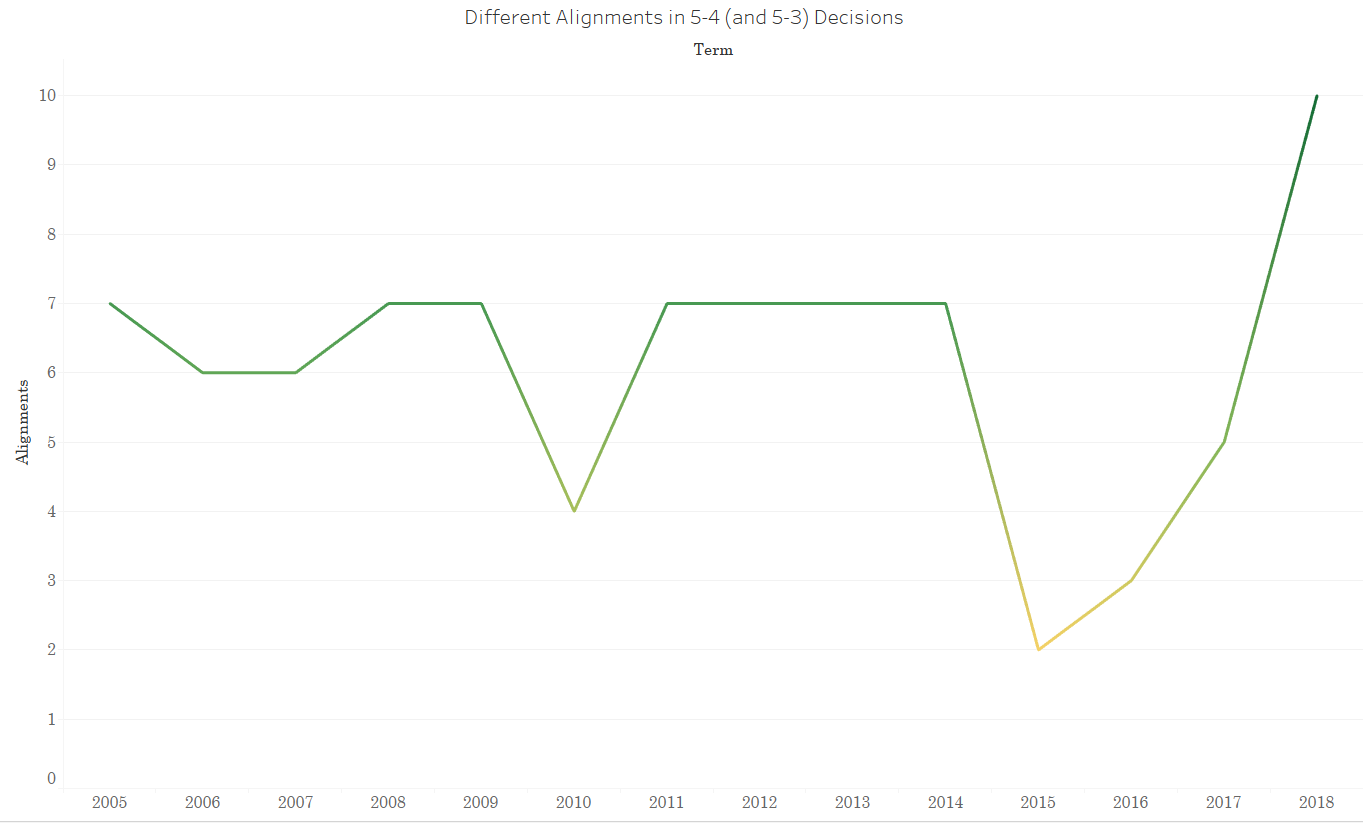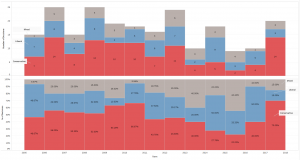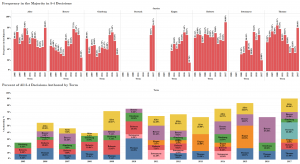Empirical SCOTUS: Changes are afoot – 5-4 decisions during October Term 2018


Every year, the SCOTUSblog Stat Pack provides readers with an unparalleled look at the business of the Supreme Court across all the merits cases it hears during a term. This year was no exception. The 2018 Term Stat Pack examines the details of the 67 cases the court decided after oral argument as well as the five summary reversals, for a total of 72 decisions this term. This post tracks some of the Stat Pack’s measures back to 2005 to compare the justices’ work over the years. It also highlights some differences that we saw this term and tracks these trends across the Roberts Court’s 14 terms so far.
Some of the most interesting facets of the justices’ work this term relate to the Supreme Court’s closest decisions in 5-4 and 5-3 splits (referred to here as 5-4 decisions), in which a single vote could change the coalition in the majority. In the past, Justice Anthony Kennedy played the role of swing justice, but after he retired at the end of last term, many were unsure who, if anyone, would inherit this role. Although Kennedy’s retirement was sure to change the composition of these majority coalitions, it was unclear to what extent this would insulate the court’s five more conservative justices in close cases. Interestingly, at the statistical level the court took a step back from the domination of conservative justices in 5-4 decisions that we saw during the 2017 term. In 2017, all the votes in 5-4 cases that split the justices ideologically went in the conservatives’ favor. By contrast, in the 2018 term only 50 percent of the ideologically split 5-4 decisions had the more conservative justices in the majority, with the majority in the other half comprised of the four more liberal justices and one conservative justice. This also led to a Roberts Court record in terms of the number of alignments in these 5-4 decisions.

The total of 10 alignments this term is up from five in the previous term and a previous high of seven since 2005. This was also the first time since Chief Justice John Roberts joined the court that we have seen each of the five more conservative justices vote with the four more liberal justices in five-justice majorities. In Gundy v. United States, Justice Samuel Alito played this role for the first time since he joined the court in 2005. Interestingly, each of the more liberal justices also voted in coalitions this term in which they were the lone liberal in the majority.
For the purpose of this post, Justice Sandra Day O’Connor/Alito, Justice Antonin Scalia/Justice Neil Gorsuch, Justice Clarence Thomas, Roberts and Justice Brett Kavanaugh are coded as conservative justices. Kennedy is not treated as a conservative or liberal justice. Justice David Souter/Justice Sonia Sotomayor, Justice John Paul Stevens/Justice Elena Kagan, Justice Ruth Bader Ginsburg and Justice Stephen Breyer are coded as liberal justices. A swing justice is counted when four conservative or four liberal justices are in the majority along with one member of the opposite ideological grouping or Kennedy. The next figure shows each of the justices’ swing votes between the 2005 and 2017 Supreme Court terms.

In this figure, we see that the greatest number of different conservative justices providing liberal swing votes in a past Roberts Court term was four in 2005. In part because O’Connor was on the court for the first portion of the 2005 term and departed after Alito was confirmed to take her seat, 10 different justices voted on cases during that term. Even so, this number of different justices providing swing votes in the liberal direction was surpassed in the 2018 term, which was the first time five different justices provided such swing votes (Here are the different majority compositions.).
Gorsuch provided the most swing votes for the more liberal justices this term with four. These decisions fell into two main areas — tribal and criminal law. Gorsuch has shown a propensity to find common ground with the more liberal justices on these issues in the past. United States v. Davis, like Sessions v. Dimaya a term earlier, dealt with unconstitutionally vague statutory language in the criminal justice context. Both cases came down to 5-4 votes, with Gorsuch siding with the more liberal justices in the majority. In the 2017 term, Gorsuch voted in the opposite direction from Alito and Thomas in Upper Skagit Indian Tribe v. Lundgren. Because Gorsuch already differentiated his position in this area from those of the other more conservative justices, his votes with the more liberal justices in the two tribal-law cases this term, Washington State Department of Licensing v. Cougar Den and Herrera v. Wyoming, were not entirely unexpected.
When we separate out the justices into coalitions in 5-4 decisions based on whether there were four liberal justices in the majority, at least four conservative justices in the majority, or a different mix of justices in the majority, we see that the greatest percentage of 5-4 decisions that went to liberal majorities in a term since 2005 was 50 percent in both the 2014 and 2016 terms. The greatest percentage that went to conservative coalitions was 70 percent during the 2017 term.

If the majority in Department of Commerce v. New York is treated as Roberts with the four more liberal justices, then coalitions with liberal justices fall just below the 50 percent mark in the 2018 term with 45 percent. Conservative coalitions were at half of their rate from 2017 during the 2018 term with 35 percent. This marks the fourth term since 2005 as well as the fourth term over the past five in which a higher percentage of liberal coalitions were in 5-4 majorities than conservative coalitions.
This term Gorsuch, who voted on the same side as the more liberal justices in four different decisions, was the justice most frequently in the majority in 5-4 decisions at 65 percent. Gorsuch was followed by Kavanaugh, who was in the majority in 61 percent of the court’s 5-4 decisions. Compared to previous terms, these are relatively low percentages for the justices most frequently in the majority in such decisions.
When we look at majority-opinion authorship in 5-4 decisions, Roberts wrote the largest percentage of these of all of the justices at 36 percent.

Each of the justices aside from Kavanaugh (who was in his first term on the court in 2018) had terms with higher frequencies in the majority in 5-4 decisions than they did this term. Gorsuch, who was at the top of this metric this term, was still in the majority nearly 20 percent more of the time last term. Roberts’ highest frequency was last term at 90 percent.
Focusing on the fraction of majority opinions authored by each justice in 5-4 decisions out of all 5-vote majority decisions for the term, both Roberts and Thomas wrote a greater percentage of such opinions than they have in previous Roberts Court terms, at 36 and 33 percent, respectively. Note that the justices no longer on the court are not shown in this figure, although their respective percentages (especially Kennedy’s) are what keeps the aggregate 5-4 decision authorship by term below 100 percent.
The Supreme Court with Kavanaugh is distinctly different from the court with Kennedy. There is no longer a clear swing vote. Justices like Gorsuch have shown willingness to side with the liberal justices in certain case areas, but this will likely only manifest in a limited set of cases each term. This term it was apparent that all justices may be attempting to reinvent their identities, at least to some extent. We can see this reinvention in the court’s 5-4 decisions in which justices appear to be willing to make concessions to reach a consensus. Still, the justices’ positions on different ideological poles are quite evident, as the coalition most frequently in the majority in 5-4 decisions was composed of the five more conservative justices, who voted together in seven of these cases. This fracture between the more conservative and the more liberal justices was especially clear in the court’s decision on partisan gerrymandering in Rucho v. Common Cause.
With a bevy of contentious cases on the horizon dealing with issues ranging from the Second Amendment, to DACA, to Title VII discrimination against transgender individuals, we should continue to see the justices split predictably on certain issues, while we might expect some surprises as the justices seek consensus in ways they never needed to with Kennedy on the court.
This post was originally published at Empirical SCOTUS.
Posted in Empirical SCOTUS
